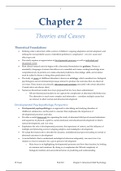1
Chapter 2
Theories and Causes
Theoretical Foundations
Defining what is abnormal within context of children’s ongoing adaptation and development, and
seeking the most probable causes of identified problems is complicated – very few cause-and-
effect rxps exist
This study requires an appreciation of developmental processes as well as individual and
situational events
Most clinical research activity begins with a theoretical formulation for guidance. Theory is
essentially a language of science that allows us to assemble and comm. existing knowledge more
comprehensively, & permits us to make educated predictions. Knowledge, skills, and evidence
must be added to theory to bring these predictions to life
The study of causes of childhood disorders is known as aetiology, which considers how biological,
psychological, and environmental processes interact to produce the outcomes that are observed
over time. These factors are primarily risk factors and correlates associated with certain disorders
(*causal role is not always clear)
Numerous theoretical models have been proposed but few have been substantiated
o NB one-dimensional models do not capture the complexities of abnormal child behaviour.
The alternative is much more complex and informative – considers multiple causes that
can interact to affect normal and abnormal development
Developmental Psychopathology Perspective
Developmental psychopathology is an approach to describing and studying disorders of
childhood, adolescence, and beyond in a manner that emphasises the importance of
developmental processes and tasks
Provides a useful framework for organising the study of abnormal child psych around milestones
and sequences in physical, cognitive, social-emotional, and educational development to inform
normal development, and vice versa
Emphasises the role of developmental processes, the importance of context, and the influence of
multiple and interacting events in shaping adaptive and maladaptive development
We adopt this framework to describe the dynamic, multidimensional process leading to normal or
abnormal outcomes in development
A central belief is that to understand maladaptive behaviour adequately, one must view it in
relation to what is normative for a given period of development
o Main focus is on highlighting developmental processes and how they function, by looking
at extremes and variations. By doing so, it emphasises the NB and complexity of
biological, familial, and sociocultural factors in predicting and understanding
H Visser SLK 310 Chapter 2 Abnormal Child Psychology
, 2
developmental changes. Draws on knowledge from several disciplines and integrates this
knowledge within a developmental framework
4 prominent assumptions derived from a developmental psychopathology perspective:
1. Abnormal Development is Multiply Determined
We have to look beyond the child’s current symptoms and consider developmental pathways and
interactive events that contribute to the expression of a particular disorder
Focusing on one primary explanation rather than identifying and allowing for several possible
explanations fails to consider the concept of developmental pathways
A particular problem may stem from a variety of causes, and similar risk factors may lead to very
different outcomes
Equifinality: sets of different circumstances (inputs) that lead to the same diagnosis (outcome)
Multifinality: sets of the same circumstances (inputs) that lead to different diagnoses (outcome)
2. Child and Environment are Interdependent
This assumption extends the influence of multiple causes by stressing how the child and
environment are interdependent (how they influence each other)
Just as the environment impacts the child, as does the child influence their environment
Interdependence appreciates how nature and nurture work together and are interconnected. Thus,
children elicit different reactions from the same environment; and different environments elicit
different reactions from the same child
The dynamic interaction of child and environment is referred to as transaction
o The child and the env both contribute to the expression of a disorder, and one cannot be
separated from the other
o Regards both children and the environment as active contributors to adaptive and
maladaptive behaviour
o Children’s psychological disorders do not reside within the child, nor are they due solely
to env causes. They most often emerge from a combo of factors, which interact in ways
that follow general laws of organised development
o Although a transactional view considers general principles of development that apply to
all children, it is also sensitive to individual circumstances
3. Abnormal Development Involves Continuities and Discontinuities
Few psychological disorders suddenly emerge without at least some warning signs or connections
to earlier developmental issues
NB to note that some forms of abnormal child development may be continuous or discontinuous
across childhood, adolescence, and adulthood, in either a consistent or a transformed manner
Continuity implies that developmental changes are gradual and quantitative, and that future
behaviour patterns can be predicted from earlier patterns. NB continuity refers to patterns of
behaviour rather than specific symptoms that remain over time. Is well supported for early-onset
and persistent conduct disorders, which have a significant likelihood of later evolving into serious
antisocial acts
Discontinuity implies that developmental changes are abrupt and qualitative, and that future
behaviour is poorly predicted by earlier patterns. These types of disorders seem to occur more
suddenly. There are few good behavioural predictors from early childhood. Can sometimes refer
to an unexpected or atypical outcome. In such circumstances, the connection between early and
later patterns seems abrupt and discontinuous
H Visser SLK 310 Chapter 2 Abnormal Child Psychology





